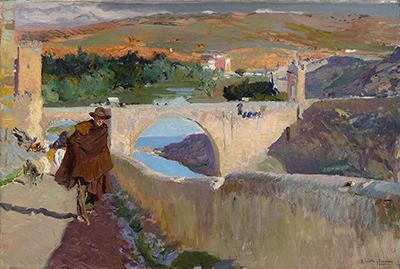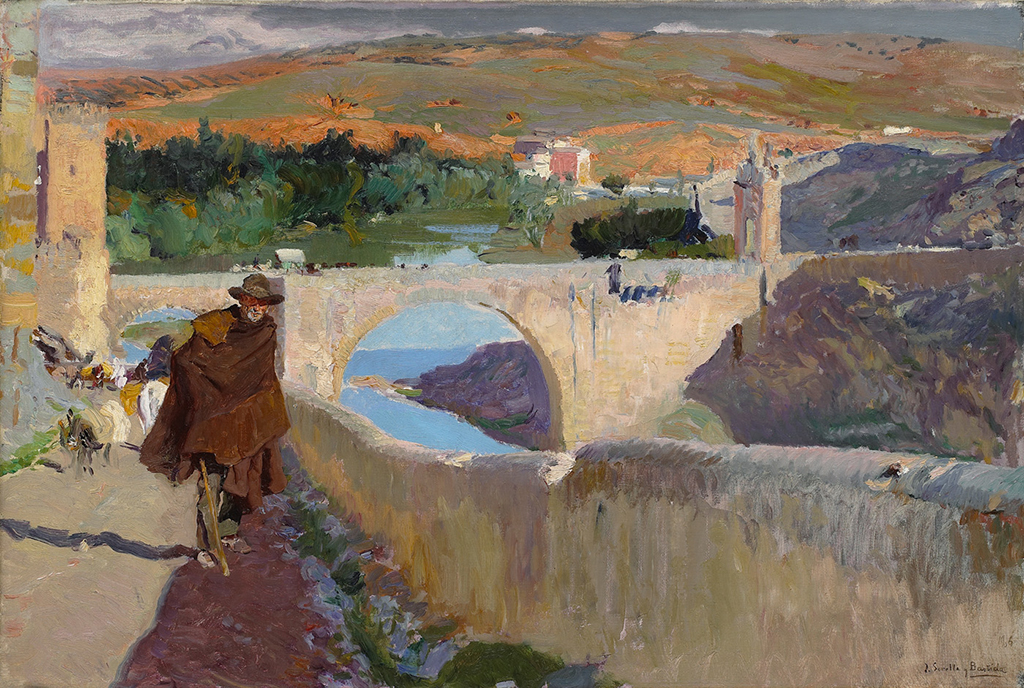 Buy Art Prints Now
Buy Art Prints Nowfrom Amazon
* As an Amazon Associate, and partner with Google Adsense and Ezoic, I earn from qualifying purchases.
Blind Man of Toledo from 1906 features a combination of portraiture and cityscape art as its creator, Joaquin Sorolla, produces another bright and uplifting piece which helped to raise the profile of Spanish art in the very early 20th century.
This composition features a single figure walking towards us slowly besides a passing river. The path appears to be steep as he makes his way through this picturesque location. In the background we see a number of fortified buildings which sit close to an attractive arched bridge that hangs over a bright blue river. Further back are some tall hills which lead up towards the top of the canvas. The lighting is carefully balanced so that some areas are brought to our attention, most notably the water as it passes under the bridge. There are also some reddish tones to the bottom of the hills that also adds further aesthetic value. The brickwall along which he walks comes up to his waist and each and every aged element of it is faithfully reproduced by the artist who could work in a number of different artistic styles. Many of his paintings would sit somewhere between Impressionism and Realism, where precise detail and his own expressive nature would have to be balanced out carefully.
A close inspection of the painting in person will reveal some other carefully crafted detail. For example, behind the blind man is a number of donkeys as this poor community go about their daily lives. Sorolla regularly made use of social commentary within his work, capturing the lives of different levels of society within his native Spain. The blind man himself actually looks fairly smart, though small details reveal his difficult life. A long stick appears from underneath his thick coat as he struggles along this path. He is a fair distance away from the artist in this work, making it harder to directly connect to his emotions, and we are left with a slighly anonymous appearance as he hides below his wide brimmed hat. Blind Man of Toledo feels entirely Sorolla, but at the same time can be considered fairly unique within his career. All of the elements that made him famous are here, but it is the combination that differs. We have the bright colours, the social commentary, and the Spanish landscape, but the inclusion of the bridge and the contemporary use of reduced detail are the points to note here.
This painting can now be found in the collection of the Meadows Museum in Dallas, USA. They have a particularly impressive selection of work from the great masters, including a number of fellow Spanish painters. They also recently had their own Sorolla exhibition in which this painting, presumably, would have been heavily involved. Visitors to this smart and professional venue will also be able to see work from the likes of Diego Velázquez, Francisco de Goya and El Greco, all of whom were actually present within Spain for parts of their career just as with Sorolla. El Greco himself was Greek but worked in Spain for many years, giving us the likes of View of Toledo, for example. You may also be interested to see the likes of Sibyl with Tabula Rasa, or Female Figure, by Diego Velazquez, Adoration of the Shepherds by Juan Bautista Maíno and also Saint Francis Kneeling in Meditation by El Greco. There is also a portrait by Francisco de Goya of his much beloved grandson, Mariano.




